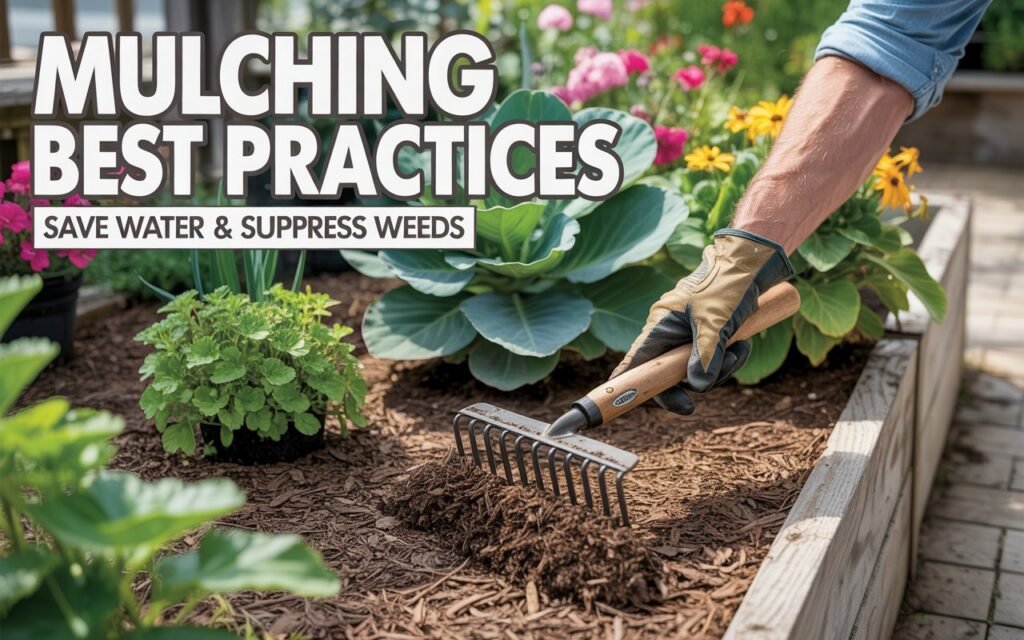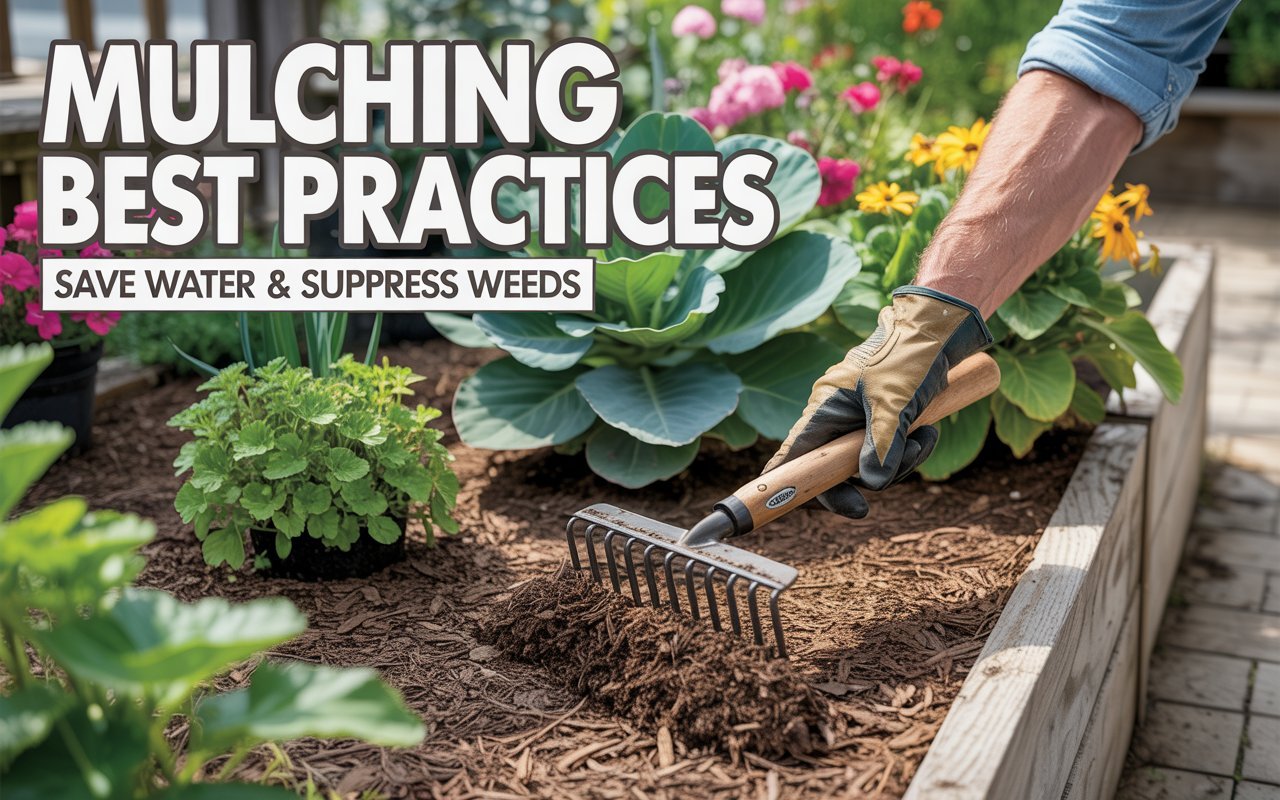Discover mulching best practices to save water and suppress weeds with simple, proven tips. Learn how mulch keeps soil moist, healthy, and weed-free.

Hi gardening friends, I’m Ashley Scott. I’ve been gardening in the U.S. for over 10 years, and one of the most helpful habits I’ve built into my routine is mulching. If you’ve ever struggled with keeping soil moist or fighting weeds that pop up overnight, then you already know how powerful the right mulch can be. In this post, I’ll share my personal experience, favorite materials, and simple mulching best practices to save water and suppress weeds.
Why Mulching Matters
When I first started gardening, I didn’t mulch enough. My plants dried out quickly, and weeds spread faster than I could pull them. Once I committed to mulching, I noticed a big difference:
- Soil stayed cooler and moist longer, especially in summer.
- Weeds reduced by at least 70% in my vegetable beds.
- Plants grew stronger and needed less frequent watering.
According to University of Minnesota Extension, mulching reduces evaporation and protects soil structure, making it one of the easiest ways to care for your garden naturally.
Choosing the Right Mulch
There isn’t a one-size-fits-all answer. Different gardens benefit from different types of mulch. Here’s what has worked for me:
Organic Mulches
- Wood chips – Great for pathways and perennial beds. I use them around my fruit trees.
- Straw or hay – Perfect for vegetable gardens. It breaks down fast and adds nutrients back to the soil.
- Grass clippings – If you mow your own lawn, this is a free mulch option. Just make sure it’s chemical-free.
- Compost – A favorite for my flower beds. It enriches the soil while suppressing weeds.
Inorganic Mulches
- Landscape fabric – Works well under gravel paths. I avoid it in vegetable beds because it restricts soil health.
- Pebbles or gravel – Good for heat-loving plants like succulents.
For more guidance, the Missouri Botanical Garden has an excellent mulch guide.
How to Apply Mulch Correctly
I’ve learned that too much mulch can be as harmful as too little. Here are some mulching best practices to save water and suppress weeds effectively:
- Clear the area first – Remove existing weeds before laying mulch.
- Check soil moisture – Water your soil before adding mulch. Mulch locks in existing moisture.
- Thickness matters – Apply mulch 2–4 inches deep. Any thicker can suffocate roots, thinner won’t stop weeds.
- Keep away from stems – Leave 2–3 inches of space around plant bases to prevent rot.
- Reapply yearly – Organic mulch breaks down and should be topped up every spring.
These steps may sound simple, but skipping them can cause mulch to invite pests or mold. The Oregon State University Extension has some useful resources on correct mulching techniques.
Saving Water with Mulch
One of the biggest benefits I’ve seen from mulching is reduced watering. In hot summers, I used to water my raised beds every other day. Now, with straw mulch, I water only 2–3 times a week. That’s a huge time and water saver.
If you live in a dry climate, try drip irrigation under mulch. It delivers water directly to the roots, while mulch prevents evaporation. Check out my detailed guide on how to water plants the right way.
Weed Control with Mulch
Weeds are the enemy of every gardener. Mulch acts like a blanket, blocking sunlight so weed seeds can’t sprout. Here are my go-to methods:
- Cardboard + mulch combo – I lay down cardboard first, then cover it with wood chips. Works wonders in creating new beds.
- Compost layer – In vegetable gardens, a thin compost layer topped with straw has kept weeds to a minimum.
- Frequent checks – No mulch is perfect, so I do a quick walk around every weekend to catch weeds early.
Want more tips? I wrote a full post on organic weed control methods.
Common Mulching Mistakes to Avoid
Over the years, I’ve made plenty of mistakes. Here are a few you can skip:
- Volcano mulching around trees (piling mulch against the trunk). This leads to rot and pests.
- Using fresh wood chips directly in vegetable beds. They tie up nitrogen and starve your plants.
- Skipping replenishment. Mulch thins out, and weeds sneak back if you don’t top it up.
The Clemson Cooperative Extension also warns about these common issues.
My Favorite Mulching Routines
Here’s how I mulch different areas of my garden:
- Vegetable beds – 3 inches of straw or hay after seedlings sprout.
- Flower beds – 2 inches of compost in spring, refreshed in midsummer.
- Fruit trees – Wood chips spread in a wide circle, leaving space around the trunk.
- Herb garden – A light layer of shredded leaves works best.
If you want more ideas, check out my post on low-maintenance gardening tips.
For More Reading
Here are a few more helpful guides from my blog that pair well with mulching:
- Clay Pot vs Plastic Pot: Best Choices for Container Plants
- 6 Tips to Water Houseplants the Right Way
- 5-Minute Garden Fixes: Quick Solutions for Common Problems
- DIY Compost Bin Ideas for Urban Backyards
- Parsley vs Coriander: Which Herb to Grow?
Final Thoughts
Mulching has been one of the simplest yet most effective changes I’ve made in my garden. By following these mulching best practices to save water and suppress weeds, you’ll spend less time fighting problems and more time enjoying your plants. Whether you choose straw, wood chips, or compost, the key is applying it correctly and keeping up with maintenance.
I’d love to hear your mulching routine. Do you prefer organic or inorganic mulch? Share your experiences in the comments, and don’t forget to explore more of my gardening tips at Ashley Garden Blog.

Leave a Reply